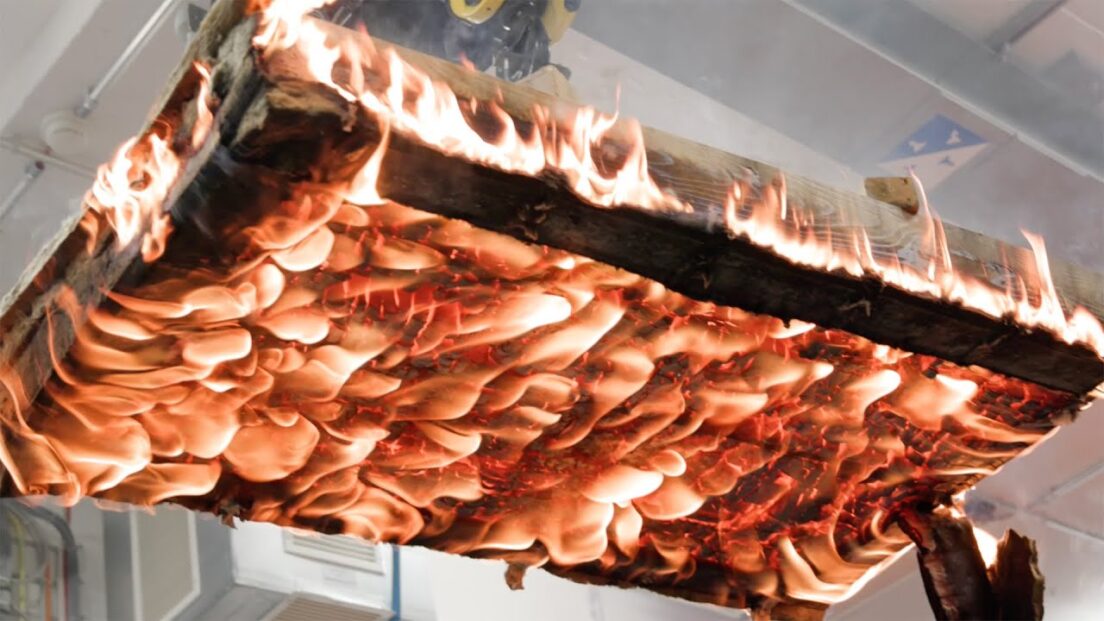A stove for safe wooden buildings

Timber construction is experiencing a renaissance in Switzerland. ETH researchers are using a fire simulator on the Hönggerberg to test wooden components for the construction of buildings of all sizes. The custom-made kiln allows the simulation of realistic fire processes.
A house fire does not always proceed in the same way. The combustible material catches fire, the temperature increases, the fire grows and spreads. The existing room volume, the fire load, the temperature and the oxygen concentration in the fire room influence its course. The latest acquisition by the Institute of Structural Analysis and Design at the Department of Civil, Environmental and Geomatic Engineering at ETH Zurich is intended to show how wooden structures behave in different fire scenarios. The knowledge gained will in turn help to expand the possible uses of wood as a safe and sustainable building material.
Precisely simulating fire processes
The furnace, which was specially developed for fire simulations, cost around 2.5 million Swiss francs including conversion measures, looks robust and is housed in the heating centre of the Hönggerberg campus. It is a metal cube reinforced with steel beams with a combustion chamber that is one metre high, one metre wide and just under 1.7 metres long. It is fired by 10 gas burners, half of which are mounted on each of the two long sides. They can heat the kiln to over 1,400 degrees. Several cameras outside the combustion chamber record the tests and the composition of the fire gases can also be analysed.
“We can precisely adjust the temperature in the kiln and also the oxygen content,” Andrea Frangi explains proudly. Furthermore, the wooden components or other common building materials can be loaded with up to 50 tonnes during the tests. The professor of timber construction initiated the procurement of the fire simulator and helped determine its specifications. “The kiln allows us to simulate different fire histories and test their effect on wood structures.”
Woodas a building material is sustainable and safe
Timber construction is booming in Switzerland. And the buildings are growing. In Regensdorf, Zug, Winterthur and Zurich, high-rise timber buildings with heights of 75 to 108 metres are currently being planned or are already under construction. The fact that this is possible at all is also due to decades of research work, such as that carried out by Frangis Group in the fire simulator. New building products and technologies for connecting wooden components are also making ever larger and more unusual constructions possible.
Until 2004, only one- to two-storey buildings with a load-bearing structure made of wood were permitted in this country. From 2005, the limit was six storeys, and since 2015 there has effectively been no upper limit. “The planned high-rise buildings are certainly lighthouse projects,” says Frangi. “But for mid-rise buildings, wood has long since established itself as a building material and convinces with a good price-performance ratio, sustainability and safety.” The latter may be surprising, but while steel beams can deform in the event of a fire and thus become unstable, timber structures can retain their structural integrity for longer.
The load-bearing capacity of a wooden beam in case of fire is essentially determined by its size. If the beam burns, about four centimetres of the wood are converted into charcoal per hour on the sides exposed to the fire. Possible weak points are connecting elements and constructional details. In order to expand the possible applications of modern timber construction, Andrea Frangi and his team want to further research the burning behaviour of timber components and connections under realistic conditions. “The construction sector causes a large proportion of climate-damaging emissions. With our research, we can help to ensure that even more of the renewable and CO2-storing resource wood is used as a building material,” Frangi is convinced.